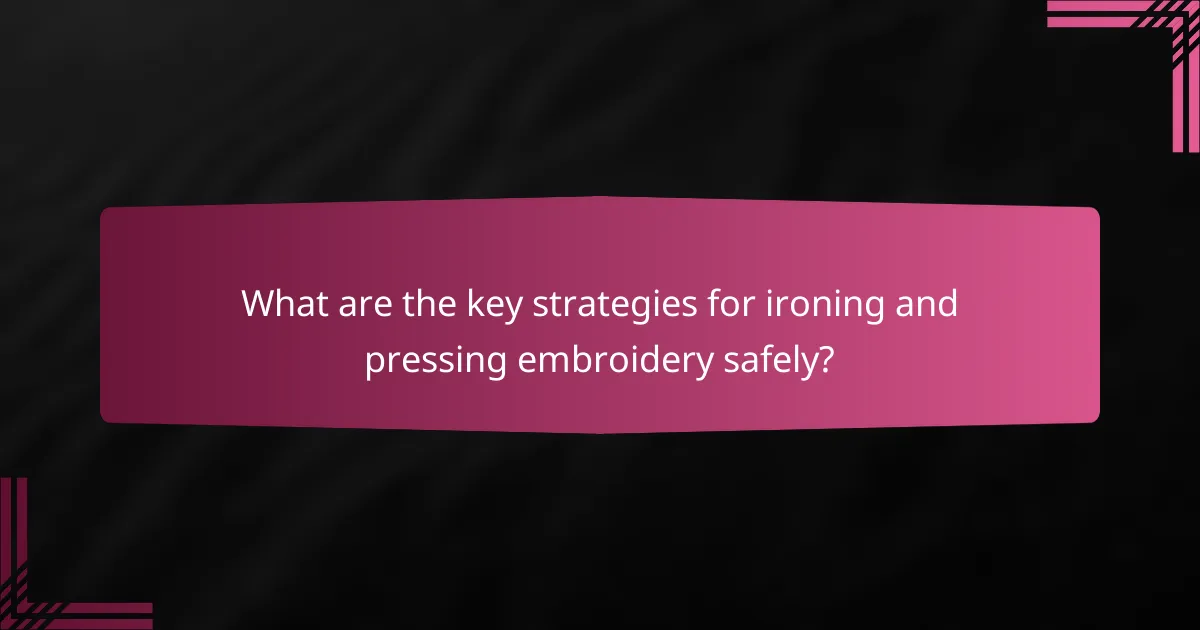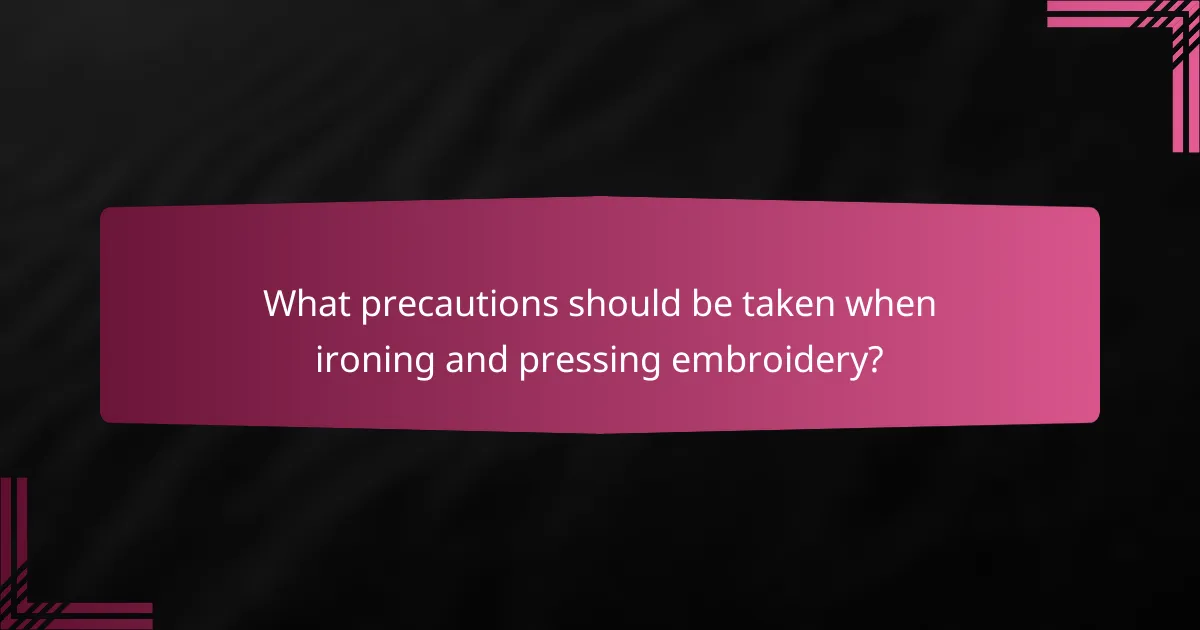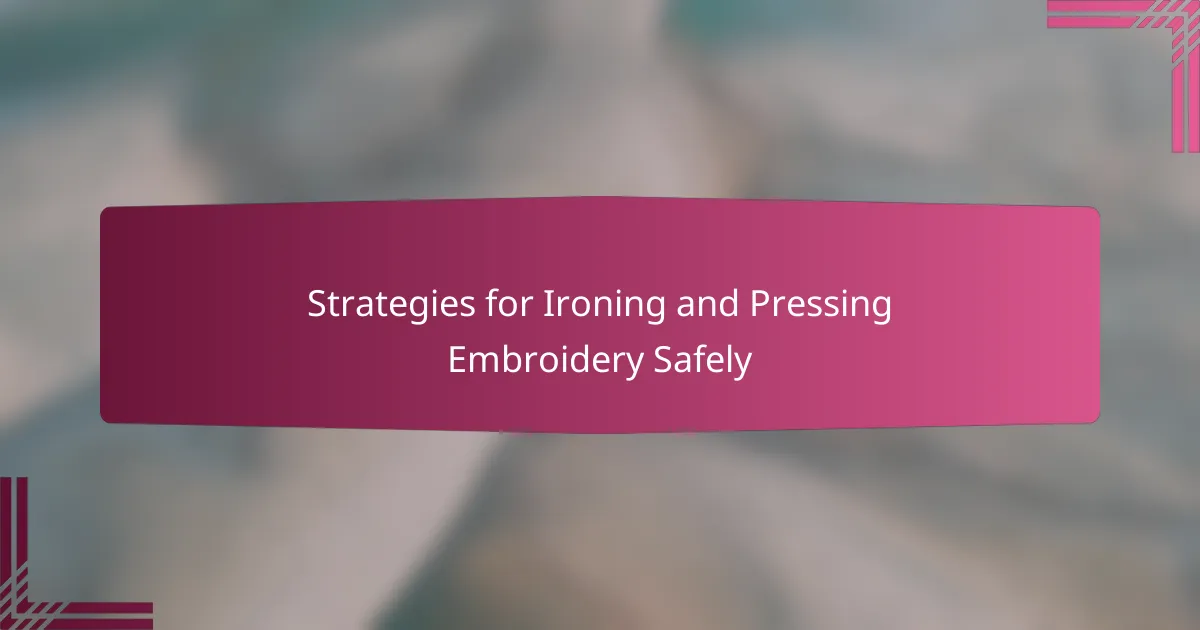
What are the key strategies for ironing and pressing embroidery safely?
To iron and press embroidery safely, use a low heat setting on your iron. High temperatures can damage the threads and fabric. Place a pressing cloth over the embroidery to protect it. This prevents direct contact with the iron. Always test the iron’s temperature on a scrap piece of fabric first. This ensures that the heat won’t cause any damage. Iron from the back of the fabric when possible. This minimizes pressure on the embroidery itself. Avoid using steam directly on the embroidery. Steam can distort the design and cause threads to fray. Lastly, allow the embroidered piece to cool completely before handling it. This helps maintain the shape and integrity of the design.
How does proper ironing technique impact embroidery quality?
Proper ironing technique significantly enhances embroidery quality. It helps to remove wrinkles and flatten fabric, ensuring a smooth surface for the embroidery. This smoothness prevents distortion of the embroidered design. Additionally, proper temperature settings preserve thread integrity and prevent melting or damage. Using steam can relax fibers, aiding in better adherence of the embroidery. A well-pressed fabric also allows for clearer visibility of the design during the stitching process. For instance, uneven surfaces can lead to misalignment of stitches. Therefore, effective ironing is crucial for achieving professional-looking embroidery results.
What specific techniques should be used to avoid damaging embroidery?
To avoid damaging embroidery, use a pressing cloth when ironing. This cloth acts as a barrier between the iron and the embroidery. Set the iron to a low heat setting suitable for the fabric. High heat can scorch threads or distort designs. Always iron from the reverse side of the fabric. This technique protects the embroidered surface. Additionally, avoid using steam directly on the embroidery. Steam can cause threads to fray or lose their shape. Instead, lightly mist the fabric if moisture is needed. Finally, ensure the embroidery is completely dry before storing or ironing. Moisture can lead to mildew or discoloration.
How can heat settings affect different types of embroidery?
Heat settings can significantly affect different types of embroidery. High heat can damage delicate fabrics and threads, leading to melting or distortion. For example, polyester threads may melt at temperatures above 300°F. Conversely, lower heat settings can help preserve the integrity of embroidery on sensitive materials like silk or chiffon. Proper heat settings ensure that embroidery remains intact and visually appealing. Adjusting heat according to fabric type prevents unwanted damage. Therefore, understanding the relationship between heat settings and embroidery types is crucial for effective pressing and ironing.
What tools are essential for safe embroidery pressing?
Essential tools for safe embroidery pressing include a steam iron, pressing cloth, and an ironing board. A steam iron provides controlled heat and moisture, which is crucial for setting embroidery stitches. A pressing cloth protects delicate fabrics from direct heat, preventing burns or shine. An ironing board offers a stable surface for effective pressing. Additionally, a seam roll can help press curved areas without flattening the embroidery. Using these tools together ensures a safe and effective pressing process for embroidered items.
Which types of irons are best suited for embroidery?
Steam irons and dry irons are best suited for embroidery. Steam irons provide moisture, which helps to remove wrinkles without damaging the fabric. They are effective for fabrics that can withstand heat and moisture. Dry irons are ideal for delicate materials that may be sensitive to steam. They offer precise temperature control, reducing the risk of scorching. Many embroidery professionals prefer irons with a pointed tip for reaching intricate areas. Additionally, irons with adjustable steam settings can accommodate various fabric types. These features enhance the ironing process while protecting the embroidery work.
What pressing aids can enhance safety and effectiveness?
Pressing aids that enhance safety and effectiveness include pressing cloths, steam irons with safety features, and silicone pressing mats. Pressing cloths protect fabric from direct heat and prevent scorching. Steam irons with auto shut-off functions reduce fire hazards when left unattended. Silicone pressing mats provide a non-stick surface, preventing fabric from sticking to the iron. Additionally, using a spray bottle for moisture can enhance pressing results without excessive steam. These aids collectively improve the ironing process while ensuring user safety and fabric integrity.

What precautions should be taken when ironing and pressing embroidery?
When ironing and pressing embroidery, use a low heat setting to prevent damage. High temperatures can scorch threads or cause them to melt. Place a pressing cloth over the embroidery to protect it from direct heat. This cloth acts as a barrier and reduces the risk of shiny spots. Avoid using steam directly on the embroidery, as it can distort the design. Instead, lightly mist the fabric if necessary. Always test the heat on a small, inconspicuous area before proceeding. This ensures the fabric can withstand the heat without damage. Lastly, handle the embroidered piece gently to avoid pulling or distorting the threads during the process.
How can fabric types influence ironing strategies?
Fabric types significantly influence ironing strategies due to their varying heat sensitivities and textures. Different fabrics require specific temperature settings to avoid damage. For instance, cotton can withstand high heat, while synthetic fibers like polyester may melt under similar conditions.
Additionally, the weave of the fabric affects how easily wrinkles can be removed. Looser weaves may require more steam and lower temperatures, while tighter weaves can handle direct heat.
Fabrics like silk require gentle handling and lower temperatures to prevent scorching. Therefore, knowing the fabric type helps in selecting the appropriate ironing technique and equipment.
Using the right strategy ensures effective wrinkle removal without damaging the fabric, leading to better care for embroidered items.
What are the best practices for handling delicate fabrics?
The best practices for handling delicate fabrics include using a gentle touch and avoiding excessive force. Always read the care label for specific instructions. Use a clean, soft cloth to protect the fabric during ironing. Set the iron to a low temperature suitable for delicate materials. Steam can be beneficial, but test it on a small area first. Always iron on the reverse side to prevent damage. Avoid hanging delicate fabrics, as this can cause stretching. Instead, lay them flat to dry. Store delicate fabrics in a cool, dry place away from direct sunlight. These practices help maintain the integrity and appearance of delicate fabrics.
How should stabilizers be treated during the pressing process?
Stabilizers should be treated with care during the pressing process. Use a low to medium heat setting to prevent damage. Avoid direct contact between the iron and the stabilizer. Instead, place a pressing cloth over the stabilizer. This helps protect it from heat and retains its function. Press gently to avoid distorting the embroidery. Always check the stabilizer’s specifications for heat tolerance. Following these guidelines ensures optimal results and longevity of the stabilizer.
What common mistakes should be avoided while pressing embroidery?
Common mistakes to avoid while pressing embroidery include using excessive heat, which can damage delicate threads. Not testing the iron’s temperature on a scrap piece first can lead to unwanted results. Failing to use a pressing cloth may cause direct contact with the iron, risking burns or melting. Pressing instead of ironing can distort the embroidery’s shape. Ignoring the fabric’s care instructions may result in irreversible damage. Lastly, neglecting to secure the embroidery can lead to shifting during the pressing process.
How can overheating affect embroidered designs?
Overheating can damage embroidered designs by causing the threads to melt or fray. High temperatures can lead to the distortion of the fabric and the embroidery itself. This results in uneven stitching and loss of detail. Additionally, overheating can weaken the adhesive used in stabilizers, leading to peeling or separation from the fabric. The color of the threads may fade or change due to excessive heat exposure. Proper temperature control is essential to maintain the integrity of embroidered designs. Using a lower heat setting can help prevent these issues.
What are the risks of using incorrect pressing techniques?
Incorrect pressing techniques can lead to fabric damage and distortion. High heat can scorch or burn fibers. Improper pressure may cause creases or unintended marks. Misalignment can result in uneven seams. These issues can ruin the quality of the embroidery. In severe cases, fabric may become irreparably damaged. Consistent use of incorrect techniques can lead to increased production costs. Proper training and technique are essential to avoid these risks.

What are the best practices for maintaining embroidery during ironing and pressing?
To maintain embroidery during ironing and pressing, always use a low heat setting. High temperatures can damage the threads and fabric. Place a pressing cloth over the embroidery to protect it. This cloth acts as a barrier between the iron and the embroidery. Avoid direct contact between the iron and the embroidered area. Instead, press around the embroidery carefully. Use steam sparingly, as excessive moisture can distort the design. Iron the reverse side of the fabric when possible. This technique helps to preserve the embroidery’s integrity. Ensure the fabric is clean and dry before ironing to prevent any heat-related damage.
How can you ensure the longevity of embroidered pieces through proper pressing?
To ensure the longevity of embroidered pieces through proper pressing, use low heat settings on your iron. High temperatures can damage the threads and fabric. Place a pressing cloth over the embroidery to protect it. This prevents direct contact with the iron. Press gently instead of sliding the iron back and forth. This reduces stress on the stitches. Allow the piece to cool flat after pressing. This helps maintain the shape and prevents creasing. Regularly check for any signs of wear or damage after pressing. This ensures timely repairs before further deterioration occurs.
What routine maintenance should be performed on embroidery tools?
Embroidery tools require regular maintenance to ensure optimal performance. Clean the tools after each use to remove fabric debris and thread remnants. Oil moving parts, such as machine needles and bobbins, to prevent rust and ensure smooth operation. Check and replace worn or damaged needles regularly to maintain stitching quality. Store tools in a dry, dust-free environment to avoid corrosion and damage. Regularly inspect threads for fraying or tangling, as this can affect the quality of the embroidery. Following these maintenance steps prolongs the life of embroidery tools and enhances their functionality.
How can you store embroidered items to preserve their quality?
To store embroidered items and preserve their quality, keep them in a cool, dry place. Avoid direct sunlight to prevent fading. Use acid-free tissue paper to wrap the items, which helps maintain their shape. Store them flat in a breathable container to avoid creasing. Ensure the storage area is free from moisture and pests. Regularly check the items for any signs of damage or deterioration. Proper storage can significantly extend the lifespan of embroidered pieces.
What troubleshooting tips can help with common pressing issues?
Check the iron temperature settings. Incorrect settings can scorch fabric or fail to press properly. Use the appropriate heat level for the specific fabric type. Ensure the steam function is working. Insufficient steam can lead to wrinkles not being removed effectively. Clean the iron’s soleplate regularly. A dirty soleplate can transfer stains to fabric. Test a small area before pressing. This prevents damage to the entire piece. Keep the fabric taut while pressing. Wrinkles can reappear if the fabric shifts. Use a pressing cloth for delicate fabrics. This protects them from direct heat exposure.
How can you fix scorch marks on embroidered fabric?
To fix scorch marks on embroidered fabric, first, test a small area with water. If the fabric is water-safe, lightly dampen a cloth and place it over the scorch mark. Use a low-temperature iron and gently press the cloth for a few seconds. This technique may lift the scorch without damaging the embroidery. If the marks persist, consider using a fabric-safe stain remover. Apply it carefully, following the product’s instructions. Rinse the area to remove any residue. Always air dry the fabric completely before further use. This method is effective for many types of embroidered fabrics.
What steps should be taken if embroidery becomes distorted during pressing?
If embroidery becomes distorted during pressing, stop the pressing immediately. Assess the distortion to determine the cause. Use a pressing cloth to protect the embroidery. Reposition the fabric to its original shape gently. Apply steam lightly to relax the fibers. Avoid direct contact with the embroidery to prevent further distortion. Allow the fabric to cool in its corrected position. Repeat the process if necessary for stubborn distortions.
Strategies for ironing and pressing embroidery safely focus on techniques that preserve the quality and integrity of embroidered pieces. Key practices include using low heat settings, employing pressing cloths for protection, and avoiding direct steam application on embroidery. The article outlines essential tools, best practices for handling various fabric types, and common mistakes to avoid, ensuring effective and safe pressing. Additionally, it provides troubleshooting tips for addressing pressing issues and maintaining the longevity of embroidered items.
